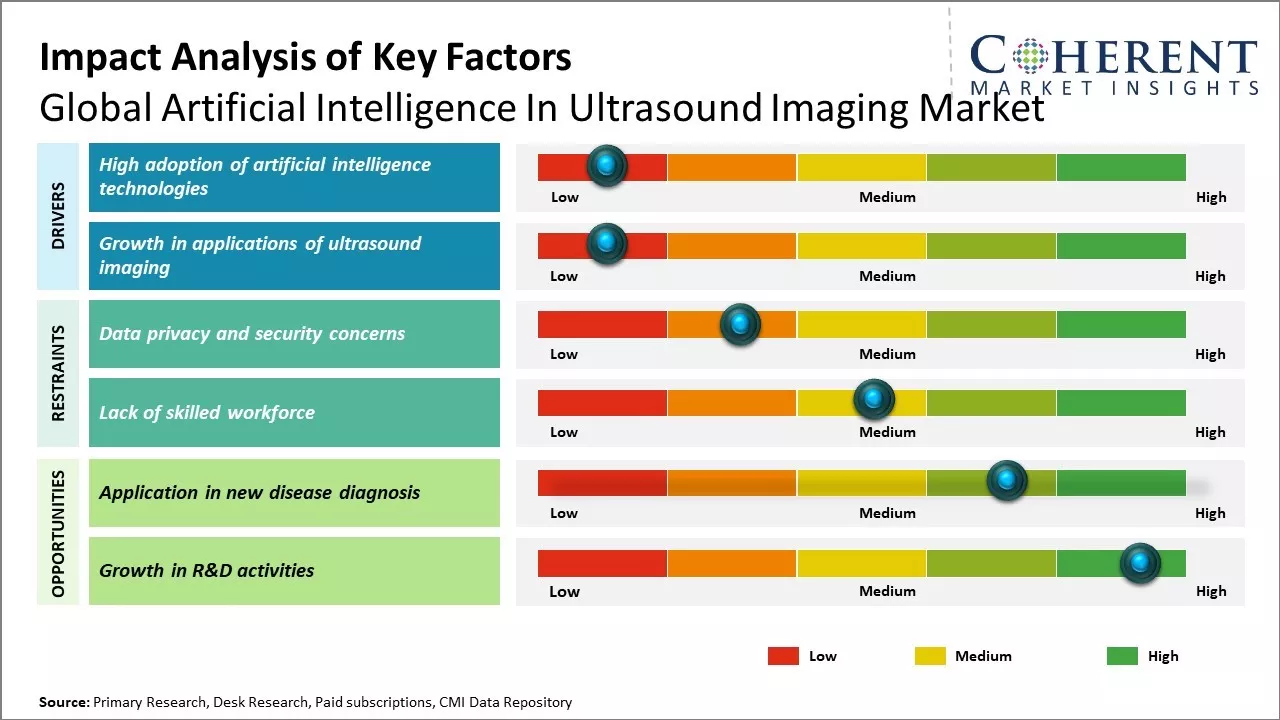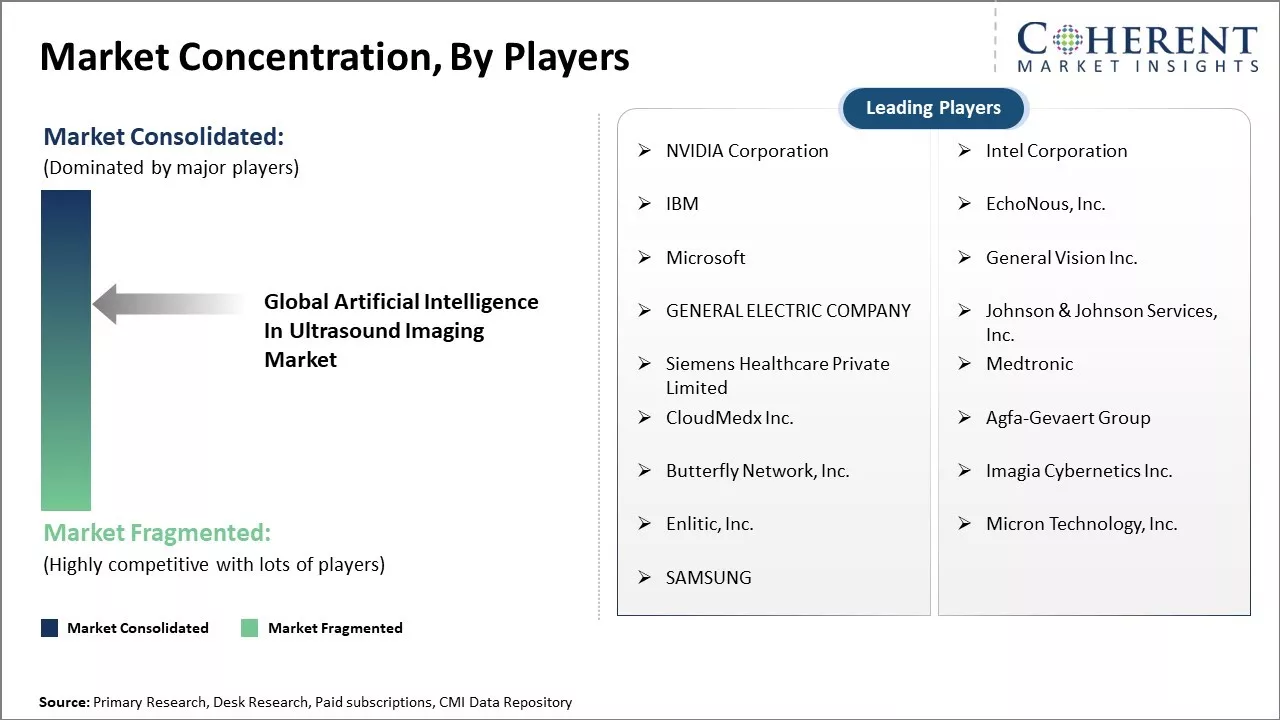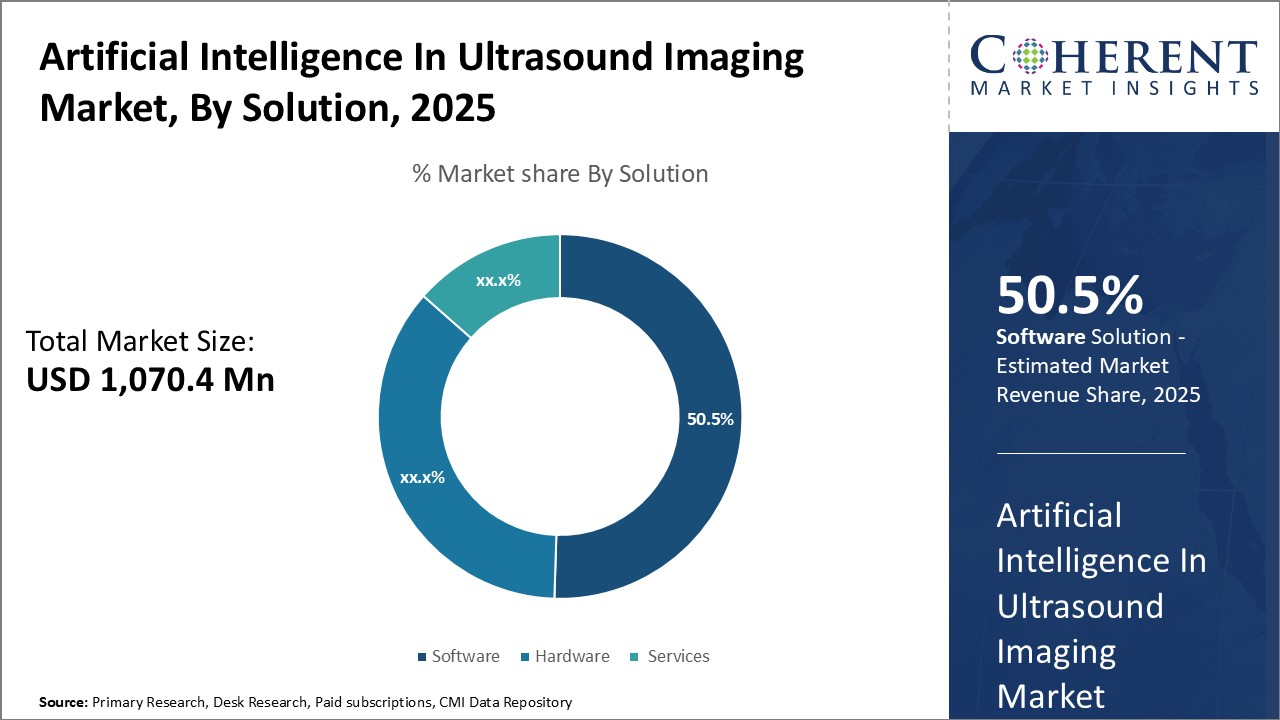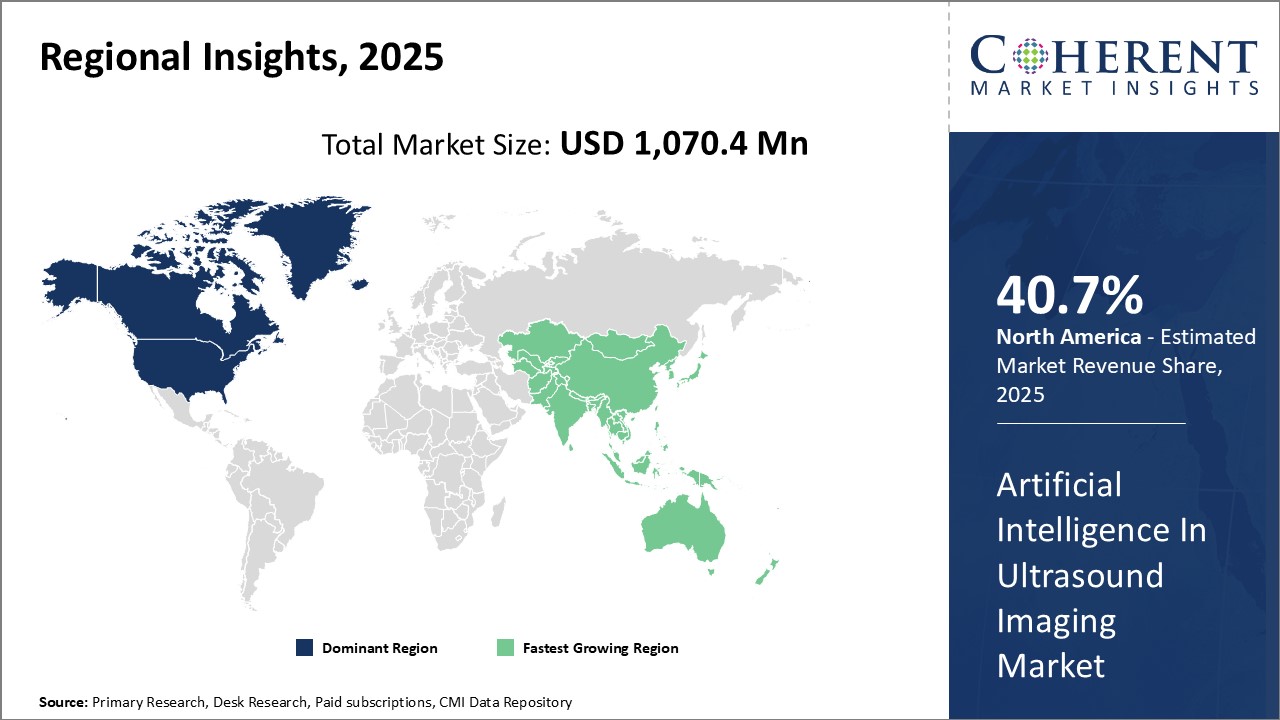The Global Artificial Intelligence in Ultrasound Imaging Market is estimated to be valued at USD 1,070.4 Mn in 2025 and is expected to reach USD 2,100.5 Mn by 2032, exhibiting a compound annual growth rate (CAGR) of 10.1% from 2025 to 2032.

Discover market dynamics shaping the industry: Request sample copy
Factors such as increasing applications of AI in medical imaging and diagnosis, rise in awareness regarding benefits of early disease diagnosis, and growing funding & investments for developing AI-driven ultrasound solutions are expected to boost the demand for artificial intelligence in ultrasound imaging market. The market is also witnessing technological advancements with integration of deep learning and machine learning algorithms in ultrasound imaging systems and devices to offer enhanced accuracy and effectiveness. Adoption of AI-based ultrasound systems enables automation in routine tasks, which otherwise require trained technicians or sonographers to perform, allowing healthcare providers to focus more on critical tasks. This improves workflow efficiency while reducing healthcare costs. Rising focus on developing affordable point-of-care and portable ultrasound devices integrated with AI is also expected to support the market growth during the forecast period.
High adoption of artificial intelligence technologies
The increasing adoption of artificial intelligence technologies across various healthcare applications has been a major factor fueling the growth of the artificial intelligence in ultrasound imaging market. Ultrasound imaging has widely adopted AI capabilities to improve diagnosis and provide more accurate results. Various AI algorithms are being developed that can learn from vast amounts of ultrasound imaging data and help radiologists and sonographers in diagnosis. For example, many solutions now use deep learning to help detect abnormalities or perform automatic analysis of ultrasound scans. This reduces workload and can help catch subtle anomalies that may be missed by humans. As the capabilities of AI enhance, its integration in ultrasound is playing a critical role in improving patient care. Going forward, the trend of incorporating AI into clinical decision support systems will continue to rise. Many big technology companies and startups are actively working on developing advanced AI tools targeted at improving ultrasound imaging workflows. It is expected that within the next few years, most new ultrasound machines will come equipped with some form of embedded AI. This will allow automated analytics at the point-of-care without needing separate solutions. As per the World Health Organization, noncommunicable diseases account for over 70% of all deaths globally. Since ultrasound is a critical tool for screening and diagnosis of many such conditions, AI can help address this growing healthcare problem by enhancing ultrasound's abilities.

Get actionable strategies to beat competition: Request sample copy
Growth in applications of ultrasound imaging
The applications of ultrasound imaging are growing exponentially which is directly fueling the growth of artificial intelligence in ultrasound imaging market on a global scale. Ultrasound imaging has transformed from being used only for obstetric procedures to now having applications in varied medical disciplines including cardiology, radiology, urology and many others. This increasing scope of use across specialties has translated into higher demand for ultrasound devices and procedures. AI is helping improve and expand the capabilities of ultrasound devices to deliver more accurate diagnoses. Technologies like machine learning and deep learning are enabling ultrasound machines to produce high quality images, perform advanced quantitative analysis and provide diagnostic assistance to radiologists. For example, AI algorithms can detect abnormalities in ultrasound scans of hearts, livers, ovaries, etc. and highlight areas which require the radiologists' special attention. This is increasing the efficiency and throughput of ultrasonography. Several ultrasound device manufacturers have also integrated AI capabilities like automated image optimization and anomaly detection into their new models.
Key Takeaways from Analyst:
The global artificial intelligence in ultrasound imaging market has strong growth potential driven by decreasing costs of AI hardware and high adoption of AI-based clinical decision support systems. As AI and machine learning algorithms advance, they can help radiologists and sonographers more accurately detect and diagnose medical conditions using ultrasound images. North America currently dominates due to heavy investments in AI by healthcare providers and diagnostic imaging centers looking to improve efficiency and throughput. Asia Pacific is expected to see the fastest growth fueled by rising medical tourism and a fast-growing middle class demanding improved access to care.
However, lack of skilled AI workforce and interoperability issues between imaging devices and AI platforms poses a challenge to wider adoption in some regions. Data privacy and regulatory concerns around AI-assisted clinical decision making could also hamper market growth. High initial costs of transitioning existing ultrasound systems to AI-based ones is a barrier for cash-strapped public hospitals globally. Successful commercialization will depend on demonstrating clear clinical benefits over diagnostic uncertainty and variation reduction compared to human interpretation alone. Ongoing partnerships between AI companies and ultrasound OEMs will be critical to design contextual, scalable solutions for different geographies and income levels.
Market Challenges: Data privacy and security concerns
Data privacy and security concerns are significantly restraining the growth of global artificial intelligence in ultrasound imaging market. With AI and deep learning being applied to ultrasound imaging, there are serious risks of patient data and images being leaked, stolen or misused. Ultrasound generates live video feed of internal organs and high-resolution images. If such sensitive data falls in the wrong hands, it can be misused for myriad unlawful purposes. This leaves patients and healthcare providers hesitant to adopt AI-powered ultrasound tools.
Lack of stringent data privacy and security regulations in many countries further exacerbates these risks. Patients are justifiably worried about how their personal health details like ultrasonography reports and scans containing anatomical details could be stored, shared and processed by third parties without proper consent or oversight. Even in developed nations, there are ongoing debates around establishing clear rules regarding ownership and management of patient data generated through AI applications. The uncertainty and fear of data breaches discourage both patients and hospitals from embracing new AI-based ultrasound technologies.
Market Opportunities: Application in new disease diagnosis
Artificial intelligence has opened up new avenues for disease diagnosis using ultrasound imaging. With the help of deep learning algorithms, ultrasound images can be analyzed to detect diseases more accurately. This represents a great opportunity for the global AI in ultrasound imaging market. AI has the potential to help radiologists and sonographers make faster and more reliable diagnoses, especially for conditions where ultrasound image interpretation may otherwise be challenging or ambiguous. Deep learning models can be trained on huge volumes of ultrasound images to recognize subtle signs that the human eye may miss. This can improve diagnosis of diseases like pneumonia, cancer, and cardiac abnormalities. For example, a 2021 study published in Nature presented an AI system that achieved an area under the receiver operating characteristic curve of 0.99 for detecting pneumonia from ultrasound videos, outperforming expert clinicians. The use of AI is also beneficial in emerging markets and rural areas that lack sufficient number of trained radiologists. Automated diagnosis using portable ultrasound machines integrated with AI could help bring quality healthcare to such underserved regions. As per WHO, accurate radiological diagnosis is not accessible to over half of the world's population. AI-powered ultrasound could help address this gap.

Discover high revenue pocket segments and roadmap to it: Request sample copy
By Solution- Rising Deployment of AI-Powered Clinical Decision Support Tools Drives Software Adoption
In terms of solution, the software segment is expected to hold the highest share of the global artificial intelligence with 50.5% in 2025 in ultrasound imaging market due to the growing utilization of AI-powered clinical decision support tools. AI software solutions are enabling clinicians to spend more time on diagnostic and therapeutic activities by automating mundane tasks. With the integration of machine learning algorithms, ultrasound software can now automatically analyze exams, detect anomalies, generate clinical reports, and aid diagnosis. This not only saves precious time but also improves diagnostic accuracy. A major factor propelling the adoption of AI software is the development of advanced applications for automated image analysis. Leading providers are focusing on enhancing the computer vision capabilities of ultrasound software to enable rapid extraction of meaningful insights from large volumes of images. For instance, some solutions can identify abnormal lesions, characterize tumors, detect fetal development stages, and monitor blood flow patterns - all through deep learning models trained on vast annotated datasets. The automation of routine image interpretation frees up radiologists to focus on complex cases. Moreover, demand is rising for AI-based clinical decision support solutions that help guide treatment decisions. Software powered by machine learning is being utilized to stratify patient risk, predict therapy responses, and recommend personalized care plans. This is especially valuable in disease areas with unclear treatment pathways such as non-alcoholic fatty liver disease. The targeted advice aids general physicians in delivering higher quality and more cost-effective care. Several startups are also developing virtual assistant technologies for ultrasound guided procedures which is another catalyst for software sales.
By Technology- Advancements in Machine Learning Algorithms Drive the Machine Learning Segment
In terms of technology, the machine learning segment is expected to hold the highest share with 35.5% in 2025 due to ongoing developments that are enhancing the capabilities of AI platforms. Machine learning lies at the core of artificial intelligence solutions, with different algorithms serving various analytical needs for ultrasound data. Supervised deep learning models in particular have vastly improved the accuracy and automation of ultrasound image interpretation. Continuous innovating in deep convolutional neural networks, generative adversarial networks, reinforcement learning, and other architectures is expanding the scope of ultrasound applications that machine learning can support. For instance, newer algorithms are allowing software to not just detect lesions but also segment them, characterize texture patterns, track tumor progression over time, and link imaging findings to genomics for personalized medicine. The higher the usefulness, the greater is provider acceptance of these advanced machine learning tools. Hardware advancements are also fueling interest, as newer ultrasound systems with powerful GPUs provide the computing infrastructure required to run sophisticated deep learning models locally within clinical settings. Besides, technological developments in transfer learning, federated learning and other distributed machine learning techniques are enabling broader utilization of scarce annotated datasets for training even more robust algorithms. Vendors are quickly monetizing these by offering cloud-based API access to deep learning models for medical imaging applications.
By Ultrasound Type - Rising Disease Prevalence and Screening Programs Boost the Diagnostic Imaging Segment
In terms of ultrasound type, the diagnostic imaging segment is expected to contribute the highest share with 40 % in 2025 due to increased clinical use of ultrasonography for disease screening and management. Population growth and aging trends have led to a sharper rise in chronic illnesses globally, thereby driving greater diagnostic testing demand. For instance, the growing problem of obesity is resulting in higher fatty liver prevalence that requires lifelong monitoring via repeated ultrasound exams. Government initiatives are also fueling the diagnostic imaging segment through organized screening programs for cancer, cardiovascular diseases and other conditions. For example, regular breast ultrasound screening is recommended for women above age 40 years in many Western countries. Similarly, initiatives to expand prenatal screening rates through affordable ultrasound are benefiting market growth in developing economies. The non-invasive nature, lack of radiation exposure, and real-time capability further support diagnostic ultrasound's role as a first-line imaging choice.

Need a Different Region or Segment? Customize now
North America has established itself as the dominant regional market. The region is expected to account for 40.7% of the market share in 2025. The region boasts a high concentration of leading AI and healthcare companies that are developing advanced ultrasound imaging solutions integrated with machine learning and deep learning capabilities. Major players based in the U.S. and Canada are at the forefront of innovation in areas such as echocardiography, radiology, and obstetrics.
Furthermore, North America has a large number of hospitals and diagnostic clinics that are equipped with the latest ultrasound devices and eagerly adopt new AI-powered tools. Regional healthcare providers recognize the value of artificial intelligence in improving diagnostic accuracy, increasing workflow efficiency, and reducing costs. Strong reimbursement policies also make AI-based ultrasound imaging solutions financially viable. Rising investments by public and private entities to build AI capabilities in the healthcare sector will continue to give North America an edge over other global markets.
Among emerging markets, Asia Pacific is expected to witness the fastest gains in artificial intelligence for ultrasound imaging. Rapid economic development and growing healthcare expenditures have enhanced diagnostic infrastructures across the region. China, India, Japan, and South Korea especially are investing heavily in new hospitals integrated with digital technologies such as AI. This creates a lucrative environment for regional and international companies to market their advanced ultrasound solutions.
Artificial Intelligence In Ultrasound Imaging Market Report Coverage
| Report Coverage | Details | ||
|---|---|---|---|
| Base Year: | 2024 | Market Size in 2025: | USD 1,070.4 Mn |
| Historical Data for: | 2020 To 2024 | Forecast Period: | 2025 To 2032 |
| Forecast Period 2025 to 2032 CAGR: | 10.1% | 2032 Value Projection: | USD 2,100.5 Mn |
| Geographies covered: |
|
||
| Segments covered: |
|
||
| Companies covered: |
NVIDIA Corporation, Intel Corporation, IBM, EchoNous, Inc., Microsoft, General Vision Inc., GENERAL ELECTRIC COMPANY, Johnson & Johnson Services, Inc., Siemens Healthcare Private Limited, Medtronic, CloudMedx Inc., Agfa-Gevaert Group, Butterfly Network, Inc., Imagia Cybernetics Inc., Enlitic, Inc., Micron Technology, Inc., and SAMSUNG |
||
| Growth Drivers: |
|
||
| Restraints & Challenges: |
|
||
Uncover macros and micros vetted on 75+ parameters: Get instant access to report
Share
Share
About Author
Ghanshyam Shrivastava - With over 20 years of experience in the management consulting and research, Ghanshyam Shrivastava serves as a Principal Consultant, bringing extensive expertise in biologics and biosimilars. His primary expertise lies in areas such as market entry and expansion strategy, competitive intelligence, and strategic transformation across diversified portfolio of various drugs used for different therapeutic category and APIs. He excels at identifying key challenges faced by clients and providing robust solutions to enhance their strategic decision-making capabilities. His comprehensive understanding of the market ensures valuable contributions to research reports and business decisions.
Ghanshyam is a sought-after speaker at industry conferences and contributes to various publications on pharma industry.
Missing comfort of reading report in your local language? Find your preferred language :
Transform your Strategy with Exclusive Trending Reports :
Frequently Asked Questions
Joining thousands of companies around the world committed to making the Excellent Business Solutions.
View All Our Clients
US Reciprocal Tax Impact Analysis On Artificial Intelligence In Ultrasound Imaging Market
Stay updated on tariff changes with expert insights and timely information